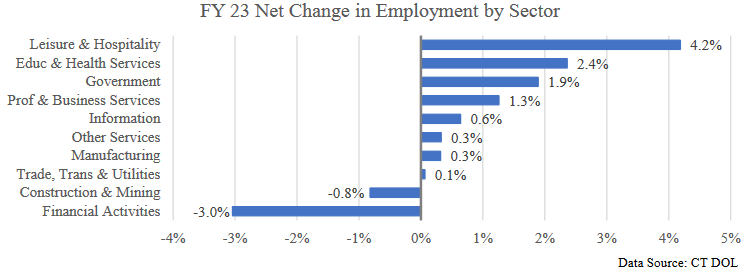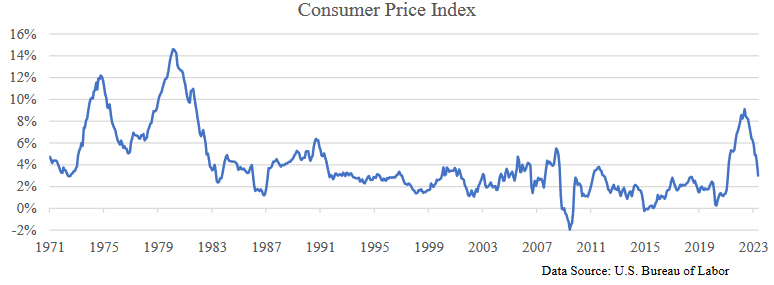
September 30, 2023
The Honorable Ned Lamont
Governor of the State of Connecticut
State Capitol
Hartford, Connecticut
Dear Governor Lamont,
I write to provide you with the legal financial statements for Fiscal Year (FY) 2023. These statements have been prepared in accordance with statutory provisions designed to incorporate designated expenditure accruals of Generally Accepted Accounting Principles into the budget process. It is important to recognize that these statements have not been fully audited at the time of this writing. The figures are subject to final audit adjustment and should be viewed as preliminary results. Final audited statements will be released on or before December 31, 2023.
The General Fund ended Fiscal Year 2023 with a surplus of $551,132,879. In a typical year, once the audit is completed, the surplus would be transferred to the Budget Reserve Fund (BRF). However, the balance in the BRF has reached the statutory limit of 15% of current year net General Fund appropriations. Therefore, a separate provision of the Connecticut General Statutes (CGS) will apply as described below. The Transportation Fund had an operating surplus of $283,972,255, which left a positive fund balance of $681,733,123 at the close of Fiscal Year 2023.
In FY 2023, for the sixth consecutive year, significant progress was made toward building and maintaining the balance of the BRF. This was primarily due to the revenue volatility cap, first implemented in FY 2018. This statutory provision requires revenues above a certain threshold to be transferred to the BRF. For FY 2023, the cap was just over $3.6 billion for estimated and final income tax payments and revenue from the Pass-through Entity tax. At year-end, a volatility transfer of $1.32 billion was made to the BRF.
Prior to the close of FY 2023, the balance of the BRF was just over $3.3 billion. Adding the $1.32 billion volatility transfer brought the BRF total to just over $4.6 billion, or 21% of net General Fund appropriations for FY 2023. As a result, the BRF was temporarily above the statutory 15% cap. According to CGS Section 4-30a (c)(1)(A), no further transfers will be made to BRF. Instead, the State Treasurer must transfer the balance above the 15% threshold as an additional contribution to the State Employee Retirement Fund (SERF) and to the Teachers' Retirement System (TRS). Earlier this month, the State Treasurer transferred $1.05 billion to SERF to reduce unfunded pension liability, with the remaining balance of $272.8 million going to TRS.
In addition, once the audit of FY 2023 operations is complete and the General Fund surplus is confirmed, the $551 million surplus will be transferred to TRS to further reduce unfunded liability. Five consecutive years of surplus and four consecutive years of a maxed out BRF represents an important benchmark for Connecticut. Due to fiscal discipline and hard work, our state is in a much stronger position to provide critical services to those in need and to weather the public health and fiscal crisis brought on by the COVID-19 pandemic and its aftermath.
General Fund
The FY 2023 budget plan as initially formulated included a built-in General Fund surplus of $299 million. Surplus estimates improved from the original budget plan due to a combination of stronger than expected revenue growth and lower than anticipated spending. In June, surplus projections that had grown to nearly $1.6 billion were reduced due to Public Act No. 23-204, the FY 2024 budget bill. Certain provisions affected FY 2023 including: 1) eliminating the use of Federal American Rescue Plan Act funds for General Fund revenue replacement, 2) increased debt service expenditures due to cancelation of the GAAP financing bonds issued in 2013 and 3) using FY 2023 lapsing funds to support spending in FY 2024 and FY 2025.
General Fund expenditures totaled $22,198,901,241 in FY 2023. This represented an increase of $1.5 billion, or 7.5% above FY 2022 spending levels. Several appropriations saw large spending increases that accounted for much of the growth in FY 2023. Medicaid, the single largest line item in the General Fund, had expenditures come in below the initial FY 2023 budget target. Despite this, however, Medicaid still experienced expenditure growth of $377.8 million or 14.8% over FY 2022, partly due to the end of pandemic-related enhanced Federal reimbursements. Contributions for Teachers' Retirement and the unfunded liability portion of the State Employee Retirement System (SERS) grew by $134.4 million and $92.6 million, respectively, as the state continued to fulfill its responsibility to fully fund its pension funds. Debt service payments increased in FY 2023 by a combined $73.8 million for General Obligation and UCONN-related bonds, primarily due to new debt issues. In addition, payments toward Pension Obligation Bonds (POBs) for Teacher's retirement, first issued in FY 2008, grew by $103.6 million over FY 2022 levels. The debt service schedule for the POBs was backloaded based on the original design of the program, so this increase was anticipated. Finally, two new line items for the Connecticut Premium Pay Program ($110.4 million) and Early Child Care Provider Stabilization Program ($69.9 million) added to higher expenditure levels in FY 2023 as the state continued its response to the effects of the Coronavirus pandemic.
General Fund salaries (all line items) grew by a nominal 11.4% in FY 2023 due to hiring, negotiated bargaining unit payments and increases, and an additional 27th payroll that fell within FY 2023 due to the timing of the payroll calendar. However, the State's GAAP-Based Budgeting methodology, first implemented in FY 2014, spread the impact over ten years, accounting for one additional day of payroll in each fiscal year. As a result, after accounting for the impact of the 27th payroll, real salary growth was approximately 5% in FY 2023. The full FY 2023 General Fund statement of appropriations and expenditures by line item is presented in Schedule B-3.
General Fund revenues totaled $22,822,893,588, which represented an increase of $832 million, or 3.8% above FY 2022 levels. Consistent with job and wage growth throughout the year, the withholding portion of the Personal Income Tax performed well, coming in above its budget target and growing by $430.9 million or 5.5% over prior year. The tax category with the largest decrease between FY 2022 and FY 2023 was the estimated and finals portion of the Personal Income Tax, which came in below the budget plan and declined by over $1.3 billion or 31.5% from the prior year. This result was primarily due to the poor performance of the stock market, with all three major indices experiencing significant losses in calendar 2022. For the other major tax categories, both Sales and Use (+$126.7 million) and the Corporations tax (+$115.4 million) grew compared with the prior year. However, Pass-Through Entity Tax decreased compared with FY 2022 (-$259.5 million), despite coming in slightly above its budget target for FY 2023. The complete statement of estimated and realized revenue for FY 2023 is presented in Schedule B-2.
Special Transportation Fund
Special Transportation Fund (STF) spending totaled $1,864,806,992 in FY 2023, growing by $138.6 million or million or 8.0% compared with FY 2022. The largest category of increase was debt service, which grew by $67 million or 9.0% above FY 2022 levels. This was primarily due to new bond issues in recent years to support greater investments in Connecticut's transportation infrastructure. Growth in the STF's program-related expenditures was largely due to the expiration of temporary Federal pandemic assistance. This included increases of $49 million in pay-as-you-go transportation projects, $19.2 million in Bus Operations, and $16.6 million in Rail Operations. Salaries in the STF (all line items) grew by $14.3 million or a nominal 5.8% in FY 2023. However, once the impact of the 27th payroll is factored in, actual growth was essentially flat compared with FY 2022.
Overall spending growth in the STF was mitigated by the net change in GAAP-based budget accruals, which reduced spending by $35.8 million in FY 2023. These accounting adjustments are designed to assign expenditures to the fiscal year in which they were incurred despite being paid out in a different year. Based on the payroll calendar and the timing of the 27th payroll, more salary and fringe benefit expenses were accrued back into FY 2022 from FY 2023 than into FY 2023 from FY 2024. These GAAP-budget related savings were incorporated in the state budget plan but turned out to be larger than expected for FY 2023, further reducing STF expenditures.
Transportation Fund revenue totaled $2,069,405,191, which was $22.5 million or 1.1% below the budget plan for FY 2023. Motor Fuels Tax receipts came in $82.4 million below target, which was largely the result of the gas tax holiday extension enacted through Public Act No. 22-1 during the November Special Session. This act extended the suspension of the 25 cent-per-gallon excise tax on gasoline by one month, followed by a five-month phase-in to restore the tax to its previous level. Compared with FY 2022 realized revenue, Motor Fuels decreased by $127.8 million or 32.8%. Positive performance by the STF Sales and Use Tax (+$43.5 million) versus the budget plan helped offset these losses. In addition, largely due to interest rate increases, STF investment income grew significantly in FY 2023, coming in $68.5 million above its budget target. The complete statement of Transportation Fund estimated and realized revenue for FY 2023 is presented in Schedule C-2.
Economic Outlook
Connecticut's budget results are ultimately dependent upon the performance of the national and state economies. FY 2023 was characterized by a steady series of Federal Reserve interest rate hikes aimed at taming inflation, with no resulting let up of the strong labor market. The tight housing market continued into FY 2023, with sales down due to a lack of inventory but home prices continuing to rise.
Connecticut's unemployment rate remained at or below 4% throughout the fiscal year, ending at 3.7%. In June of 2023, there were 90,000 jobs open with only 70,100 people actively looking for jobs. Over the course of the fiscal year the state added 20,400 nonfarm jobs, and by June the state recovered 96.4% of the 292,400 jobs lost in March and April of 2020. Three industry sectors gained jobs above pre-pandemic levels: construction, professional and business services, and trade, transportation, and utilities. Overall, eight industry sectors experienced annual growth and two declined year-over year. Leisure and hospitality, the industry most affected by the pandemic, had the greatest net change in employment.

On a national level, over the course of FY 2023, the U.S. added 3.3 million jobs. The nation recovered 100% of the 22 million jobs lost in March and April of 2020 by the end of the prior fiscal year. This trend continued into FY 2023 with the U.S. unemployment rate and total number of unemployed persons remaining low at 3.6% and 6 million respectively. All industry sectors grew over FY 2022 levels, and notable job gains occurred in leisure and hospitality, professional and business services, and trade, transportation, and utilities.
In March of 2022, the Federal Reserve began a string of 10 consecutive interest rate hikes to try to ease inflation. The fiscal year ended with the federal funds target rate at 5-5.25%, the highest level since 2007. While leading to costlier mortgages, credit cards, and other loans, these rate increases did have the desired effect of bringing down inflation, with the consumer price index ending FY 2023 at 3.0%.

The S&P 500 Index ended 2022 at 3,928.86, a decline of 19.44% for the calendar year, just narrowly avoiding a bear market. However, the stock market rallied in the first half of calendar 2023 erasing most of its losses, as concerns eased that the Federal Reserve would go too far in raising interest rates and tip the economy into recession.
FY 2023 saw the continued boom of the housing market both nationally and in Connecticut despite increasing interest rates. A trend persisted of low inventory and high prices reducing the total number of sales. Over the fiscal year in Connecticut, sales of all property types decreased 26.9%, according to Berkshire Hathaway Home Services while the median sales price increased over 8%. Average days on the market were 28 days. At the same time, the average sales price of properties sold in Connecticut was above than the list price.
All quarters of FY 2023 saw growth in Gross Domestic Product (GDP). Connecticut generally followed national GDP trends but saw lower levels of growth, rising 2.5% in the third quarter, 0.1% in the fourth quarter of 2022, and 0.3% in the first quarter of 2023.
My office also issues an Annual Comprehensive Financial Report as an accounting supplement to the budgetary report. This annual report includes financial statements for all state funds and component units prepared in accordance with Generally Accepted Accounting Principles (GAAP). From a balance sheet perspective, the GAAP unassigned fund balance in the General Fund was a negative $771.5 million as of June 30, 2022. I will report the new unassigned fund balance figure for Fiscal Year 2023 no later than February of 2024 in accordance with U.S. Securities and Exchange Commission (SEC) requirements.
If you have any questions on this report, please do not hesitate to contact me.
Sincerely,

Sean Scanlon
State Comptroller